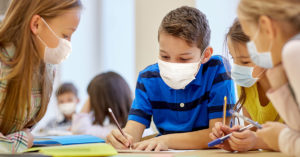
School teachers and staff are walking into their schools and classrooms facing a completely new dynamic than they have ever had before. Teachers are balancing a variety of learning situations, including face-to-face and virtual learning, sometimes at the same time. As schools reopen and students return to the classroom, school officials must take precautions inside the classroom to keep teachers and students safe at school. Physical distancing, practicing good hygiene, and cleaning the classroom will all be critical pieces for protecting teachers, staff, and students. It’s important for schools to keep classrooms safe through a combination of preparation and having the right PPE classroom essentials.
Physical Distancing
Physical distancing is a major key to school safety. In the classroom, the primary way to maintain physical distancing is by rearranging desks and seating areas to maximize the space between students. Ideally, desks should be placed at least 6 feet apart. Desks should also be turned to face in the same direction.
In some classrooms, physical distancing is harder to maintain, and partitions can help provide a layer of protection. Available in a variety of sizes and configurations, these sneeze guards can be used as student desk dividers to help protect students and teachers.
Desks spaced apart helps with physical distancing while the students are in the classroom, but there are many times that students need to enter and exit the classroom as well. Using social distancing and directional floor decals can encourage social distancing and indicate the correct traffic flow. Floor decals are an easy visual reminder for physical distancing. These safety signs help students avoid crowding together when leaving the classroom or gathering too close in hallways and unintentionally rubbing elbows with other students.
Other ways to encourage physical distancing are to
- Stagger arrival and dismissal
- Stagger lunch breaks
- Limit the mixing of classes
- Encourage students not to gather in groups
Students will likely need frequent reminders to physically distance from one another. In addition to floor decals, mounted and freestanding signs are a good way to visually remind students.
Going hand in hand with physical distancing is mask-wearing. It’s important that students, teachers, and staff use masks appropriately and consistently while at school. Students may need to be told when and how to wear their masks as well as how to handle and store masks properly.
In addition to masks, teachers may also want to use face shields or goggles. When worn together, these PPE items can protect against fluids and splashes.
Practicing Good Hygiene
Hand washing or sanitizing is one of the easiest and most effective ways to keep teachers and students safe at school. Schools can prepare and maintain hand-washing stations with soap and water as well as place hand sanitizer dispensers or pump-top hand sanitizer bottles in each classroom and other designated areas.
Teachers can encourage students to get into the practice of regularly washing their hands or applying hand sanitizers. Perhaps the most effective way to encourage students to practice good hygiene is for teachers and staff to demonstrate good hygiene practices. Identify key moments for hand washing or sanitizing, such as
- Entering and leaving the classroom
- Before and after lunch
- Leaving and entering the school building for breaks
- Touching common surfaces, learning materials, or books
Health and safety signage can reinforce the idea of frequent and routine handwashing through clear and concise communication. Hang these signs in classrooms, restrooms, and throughout the school building.
Cleaning and Disinfecting
Desks, countertops, doorknobs, computer keyboards and other high-touch surfaces need to be wiped down multiple times a day. Within the classroom, teachers and students can use antibacterial wipes to sanitize high-touch areas and other hard surfaces. Students can wipe down their desks between activities or before and after eating lunch at their desks.
Teachers and staff can also look for opportunities where touching surfaces could be eliminated. For example, classroom doors could be left open at the start and end of the day to keep each student from touching the door as they enter or exit. Teachers can also encourage students to avoid touching the walls or railings as they move throughout the school building.
As schools bring students back into the classroom, it’s important to keep teachers, staff, and students safe. Having the right PPE classroom essentials along with physical distancing, practicing good hygiene, and cleaning the classroom is key for a safe learning environment. Safeguard is your one-stop-shop for all of your PPE classroom essentials, with PPE products you need in bulk, in stock, in the US, and ready to deliver. Contact your Safeguard advisor or call 855.779.3124 to get started.
Key Takeaways
- Physical distancing, practicing good hygiene, and cleaning the classroom are key for a safe learning environment.
- It’s important for schools to keep classrooms safe through a combination of preparation and having the right PPE classroom essentials.
- Floor decals, health and safety signage, masks, hand sanitizer, and antibacterial wipes are all PPE classroom essentials.
- Safeguard is your one-stop-shop for all of your PPE needs.